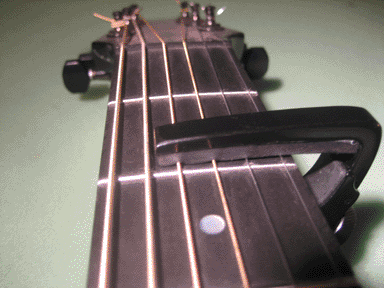Recently got hold of a Planet Waves "Trio" partial capo, which is good for either four or five outer strings:
Based on the limited look I've given it so far, this may become a real workhorse. Capoed 001111 in the C2-G2-D3-A3-E4-B3 tuning I've had the Ovation in lately, that makes a really nice open Cm11 with roots on sixth and first strings, with some lovely minor intervals for the offset harmonic nodes. Then, today, testing out a new tuning Bb1-F2-C3-G3-D4-G4 capoed 003333 on the SoloEtte (for a Bbsus across open strings and more open intervals across the offset harmonic nodes), I was struck again at how nice it is to have predictable notes above the capo. Going back to the Ovation, I turned things around and capoed 444400 (which would be what, E6/9 I think? It's late) and quickly found some really nice major mode territory to play with. Yeah, I think I'll like this 4-stringer.
Need to order the 1- and 2-string "G-Bands" for capoing one and two outer strings, and get the Shubb "Esus" partial capo for stopping three adjacent inner strings. With those four capos in the arsenal, along with the Third Hand, one should be able to do everything that you can do with a partial capo, and I'm looking forward to trying them all out. It's a nifty idea!
Wanted to document the tunings I'm currently working with, so I don't forget:
- C2-G2-D3-A3-E4-B3. All fifths, but with the wrinkle of the first string being lower than the second. Jury's still out on this one in the melodic sense, but harmonically it is really nice having three four-string groups all in fifths, and the top four strings now put the third degree on top in the most convenient "root inversion" shape. And that 001111 partial capo is intoxicating.
- Bb1-F2-C3-G3-D4-G4. Huge range, but starting to get funky with string gauges. Even with a 59 on the sixth string, that's a bit floppy, and on the other hand that high G (the same G that the Guitar Craft uses for the first string and twelve-stringers use for the third-string octave) is either too tight for good slap harmonics, or might start to lose real volume with a suitably tiny string gauge. (The second-octave and major-third harmonics on the G string, capoed up to Bb, are some high notes. :-) Jury's out on this one too, but I'll play with it some more. Melodically I do like that fourth "on top", because if your root note is the open first string, the second string is the fifth degree, down. That's got some conveniences.
- D3-D2-A2-E3-B3-E4. This one occurred to me today, for nylon-string instruments, whose string-gauge requirements are much more of a challenge than steel-string ones. The idea is to have a core four-string group, all fifths, in the middle, for melodic work and basic chord construction, letting the sixth and first strings perform outlier tasks. The first string is a fourth up from the second, giving that V-I option that is such a strength of standard tuning, and also enabling both convenient power chords as a 3-string barre over 1-2-3 and also convenient octaves on 1 and 3 (that latter sounds nice). The sixth string, on a nylon, is just not going to go down to G1 (nor is the first string going to go much above E4), so why not make that an octave too, a la the "Aerial Boundaries" tuning but in reverse? I'll string up the beater classical with that arrangement and see how it goes.
Time to change that. Some of these ideas are worth pursuing. :-)



No comments:
Post a Comment